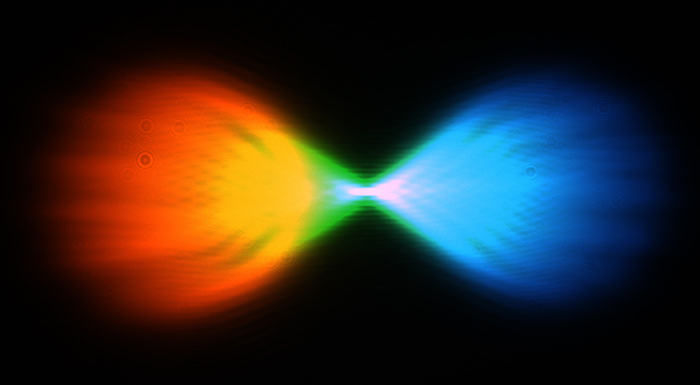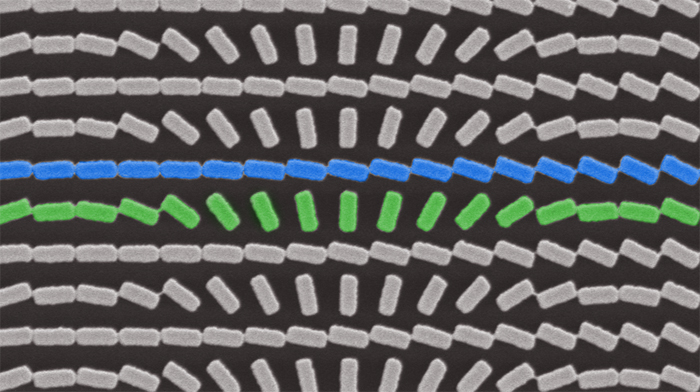
Imaging with the multispectral chiral lens forms two images of the beetle, Chrysina gloriosa, on the color camera. The left image was formed by focusing left-circularly polarized light reflected from the beetle and the right image was formed from right-circularly polarized light. The left-handed chirality of the beetle’s shell can clearly be seen. Credit: Image courtesy of the Capasso Lab/Harvard SEAS
Multifunctional lens could replace bulky, expensive machines. Many things in the natural world are geometrically chiral, ie they cannot be superimposed onto their mirror image. Think hands – right and left hands are mirror images but if you transplanted a right hand onto a left, you’d be in trouble. Certain molecules are chiral, including DNA and amino acids.

Image of optical fiber (pumped with braodband light) formed by Multispectral Chiral Lens (Image courtesy of the Capasso Lab/Harvard SEAS)
Light can also be chiral. In chiral light, the direction of oscillation of the electromagnetic wave, ie polarization, rotates clockwise or counterclockwise. Materials made of chiral molecules reflect light differently depending on the nature of their chirality. The artificial sweetener Aspartame, for example, is chiral. One chirality of the molecule is sweet, the other bitter. Drugs can also be chiral. Perhaps the most infamous example of chirality is the Thalidomide molecule. One version of the molecule acts as a sedative to pregnant women, the other caused terrible birth defects in thousands of children. As a result, being able to observe and analyze the chirality of an object is very important in many fields.
However, current chiral imaging techniques to resolve polarization and spectral (color) information require multiple cascading components, leading to bulky and expensive pieces of equipment. Now, researchers at the Harvard John A. Paulson School of Engineering and Applied Sciences (SEAS) have developed an ultra-compact, flat lens that can simultaneously capture both spectral information and the chirality of an object.

Two arrays of titanium oxide nanofins, scale bar 600 nm (Image courtesy of the Capasso Lab/Harvard SEAS)
“For the first time, chiroptical properties can be probed across the entire visible spectrum using only a single planar lens and a camera without the addition of other optical components,” said Prof. Capass. “We have demonstrated the potential of metalenses in realizing a compact and multifunctional device with unprecedented chiral imaging capabilities.”
The lens consists of 2 arrays of titanium oxide nanofins on one glass substrate, which forms 2 images of opposite chirality. To demonstrate the efficacy of the lens the team imaged the chiral exoskeleton of a beetle. “The chiral lens is very compact, only 3 mm in diameter and thinner than hair, allowing us to integrate it into portable devices,” said Chen. https://www.seas.harvard.edu/news/2016/06/ultrathin-flat-lens-resolves-chirality-and-color








Recent Comments